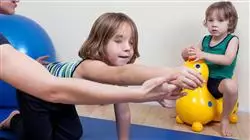University certificate
The world's largest faculty of physiotherapy”
Introduction to the Program
Use the best educational methodology to continue your education in the field of Pediatric Orthopedics"

This high-level education will provide a chapter-by-chapter review of the most important units facing a physical therapist, offering a comprehensive specialty perspective for any professional who wishes to stay up to date in Skeletal Dysplasias and Infections in Pediatric Orthopedics.
The physical therapy professional will be able to update their knowledge on the most common pathologies in children's orthopedic patients, as well as on the musculoskeletal and neuromuscular alterations they present. In particular, the different orthoses and support products will be studied in depth, as well as their characteristics and their application objectives.
The field of physical therapy that seeks to promote the health and well-being of children by advising, treating and caring for those infants who have a general developmental problem or movement disorder, which may be caused by congenital or acquired disease. This field is also essential to prevent future ailments in infants who need a follow-up to ensure their proper development. Therefore, this program focuses on building the skills needed by the professional to specialize in this field, learning to address some of the most common pathologies in childhood and the adaptability of different techniques and treatments.
Throughout this education, the student will address the most common pathologies in the pediatric patient and the related risk factors. For this purpose, key elements such as etiology, pathophysiology, clinical manifestations and evolution will be described, together with some of the therapeutic intervention techniques. Likewise, the student will study in depth Infantile Cerebral Palsy, what this pathology is about and its prevalence. Several ways to classify the ICP will be shown, such as the Gross Motor Function Measure, the types according to the affectation of the muscle tone, etc. Finally, the anatomy, function and development of the Nervous System will be described, as well as plasticity, motor learning and its assessment.
With this online program, students can organize their time and pace of learning, adapting it to their schedules, in addition to being able to access the contents from any computer or mobile device.
If you want to improve your daily practice, don’t hesitate to broaden your knowledge with this intensive program”
This Postgraduate diploma in Skeletal Dysplasias and Infections in Pediatric Orthopedics contains the scientific most complete and up-to-date scientific program on the market. Its most notable features are
- Developing practical cases presented by experts in Pediatric Orthopedics
- The graphic, schematic, and practical contents with which they are created, provide scientific and practical information on the disciplines that are essential for professional development
- The latest developments in Pediatric Orthopedics
- Practical exercises where the self-assessment process can be carried out to improve learning
- Special emphasis on innovative methodologies in Pediatric Orthopedics.
- Theoretical lessons, questions to the expert, debate forums on controversial topics, and individual reflection assignments
- Content that is accessible from any fixed or portable device with an internet connection
With this program you will have the opportunity to master new techniques and advances in Pediatric Orthopedics”
The program’s teaching staff includes professionals from the sector who contribute their work experience to this training program, as well as renowned specialists from leading societies and prestigious universities.
The multimedia content, developed with the latest educational technology, will provide the professional with situated and contextual learning, i.e., a simulated environment that will provide immersive courses programmed to learn in real situations.
This program is designed around Problem-Based Learning, whereby the professional must try to solve the different professional practice situations that arise throughout the program. For this purpose, the professional will be assisted by an innovative interactive video system created by renowned and experienced experts..
Cutting-edge training created to propel you toward greater competitiveness in the job market"

This 100% online Postgraduate diploma will allow you to combine your studies with your professional work while expanding your knowledge in this field"
Why study at TECH?
TECH is the world’s largest online university. With an impressive catalog of more than 14,000 university programs available in 11 languages, it is positioned as a leader in employability, with a 99% job placement rate. In addition, it relies on an enormous faculty of more than 6,000 professors of the highest international renown.

Study at the world's largest online university and guarantee your professional success. The future starts at TECH”
The world’s best online university according to FORBES
The prestigious Forbes magazine, specialized in business and finance, has highlighted TECH as “the world's best online university” This is what they have recently stated in an article in their digital edition in which they echo the success story of this institution, “thanks to the academic offer it provides, the selection of its teaching staff, and an innovative learning method aimed at educating the professionals of the future”
A revolutionary study method, a cutting-edge faculty and a practical focus: the key to TECH's success.
The most complete study plans on the university scene
TECH offers the most complete study plans on the university scene, with syllabuses that cover fundamental concepts and, at the same time, the main scientific advances in their specific scientific areas. In addition, these programs are continuously being updated to guarantee students the academic vanguard and the most in-demand professional skills. In this way, the university's qualifications provide its graduates with a significant advantage to propel their careers to success.
TECH offers the most comprehensive and intensive study plans on the current university scene.
A world-class teaching staff
TECH's teaching staff is made up of more than 6,000 professors with the highest international recognition. Professors, researchers and top executives of multinational companies, including Isaiah Covington, performance coach of the Boston Celtics; Magda Romanska, principal investigator at Harvard MetaLAB; Ignacio Wistumba, chairman of the department of translational molecular pathology at MD Anderson Cancer Center; and D.W. Pine, creative director of TIME magazine, among others.
Internationally renowned experts, specialized in different branches of Health, Technology, Communication and Business, form part of the TECH faculty.
A unique learning method
TECH is the first university to use Relearning in all its programs. It is the best online learning methodology, accredited with international teaching quality certifications, provided by prestigious educational agencies. In addition, this disruptive educational model is complemented with the “Case Method”, thereby setting up a unique online teaching strategy. Innovative teaching resources are also implemented, including detailed videos, infographics and interactive summaries.
TECH combines Relearning and the Case Method in all its university programs to guarantee excellent theoretical and practical learning, studying whenever and wherever you want.
The world's largest online university
TECH is the world’s largest online university. We are the largest educational institution, with the best and widest online educational catalog, one hundred percent online and covering the vast majority of areas of knowledge. We offer a large selection of our own degrees and accredited online undergraduate and postgraduate degrees. In total, more than 14,000 university degrees, in eleven different languages, make us the largest educational largest in the world.
TECH has the world's most extensive catalog of academic and official programs, available in more than 11 languages.
Google Premier Partner
The American technology giant has awarded TECH the Google Google Premier Partner badge. This award, which is only available to 3% of the world's companies, highlights the efficient, flexible and tailored experience that this university provides to students. The recognition as a Google Premier Partner not only accredits the maximum rigor, performance and investment in TECH's digital infrastructures, but also places this university as one of the world's leading technology companies.
Google has positioned TECH in the top 3% of the world's most important technology companies by awarding it its Google Premier Partner badge.
The official online university of the NBA
TECH is the official online university of the NBA. Thanks to our agreement with the biggest league in basketball, we offer our students exclusive university programs, as well as a wide variety of educational resources focused on the business of the league and other areas of the sports industry. Each program is made up of a uniquely designed syllabus and features exceptional guest hosts: professionals with a distinguished sports background who will offer their expertise on the most relevant topics.
TECH has been selected by the NBA, the world's top basketball league, as its official online university.
The top-rated university by its students
Students have positioned TECH as the world's top-rated university on the main review websites, with a highest rating of 4.9 out of 5, obtained from more than 1,000 reviews. These results consolidate TECH as the benchmark university institution at an international level, reflecting the excellence and positive impact of its educational model.” reflecting the excellence and positive impact of its educational model.”
TECH is the world’s top-rated university by its students.
Leaders in employability
TECH has managed to become the leading university in employability. 99% of its students obtain jobs in the academic field they have studied, within one year of completing any of the university's programs. A similar number achieve immediate career enhancement. All this thanks to a study methodology that bases its effectiveness on the acquisition of practical skills, which are absolutely necessary for professional development.
99% of TECH graduates find a job within a year of completing their studies.
Postgraduate Diploma in Skeletal Dysplasias and Infections in Pediatric Orthopedics.
Skeletal dysplasia is a medical term used to refer to a wide variety of disorders that affect bone development in newborns and children. These disorders occur due to abnormalities in bone development during pregnancy or after birth. Some of the more common skeletal dysplasias include hip dysplasia, metaphyseal dysplasia, and ectodermal dysplasia. These conditions can cause bone deformities, limited mobility, pain and other symptoms.
In pediatric orthopedics, treatment of skeletal dysplasias is based on early detection and surgical intervention. In some cases, orthopedic devices, such as braces or splints, are used to assist normal bone development.
Infections in pediatric orthopedics, on the other hand, are infections that affect the bones, joints and muscles of children. These infections can be caused by bacteria, viruses, fungi or other microorganisms. Infections in pediatric orthopedics can occur as a result of injury, surgery or a weakened immune system. Symptoms may include pain, swelling, fever, limited movement and other symptoms.
Treatment of pediatric orthopedic infections depends on the severity and cause of the problem. In some cases, antibiotic medications or other treatments may be prescribed. In more severe cases, surgery may be necessary to treat the infection and restore normal function to the child's musculoskeletal system.
TECH the world's largest digital university has an academic program designed to provide students with advanced knowledge and skills for the diagnosis and treatment of the most common orthopedic complications in children, such as skeletal dysplasias and bone infections. Students will learn important aspects such as the integration of bone development, physiological changes during growth, and pediatric bone anatomy and pathology. They will also learn how to diagnose skeletal dysplasias and bone infections, and through state-of-the-art techniques provide the most appropriate treatment to correct these orthopedic ailments in children.







